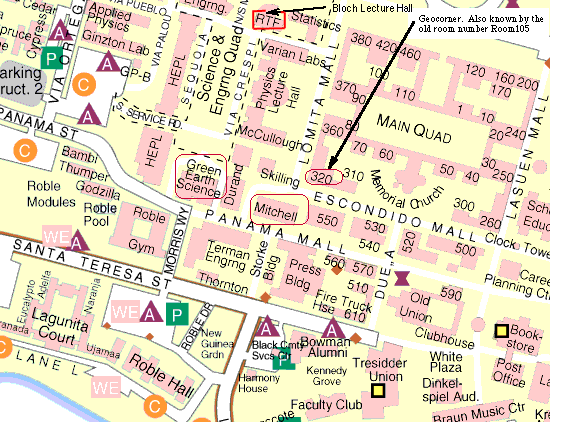

This will be the 321st meeting since 1954.

Location: Stanford University
Anyone wishing to attend the tour and lecture only is welcome at no cost.
This region contains one of the world's largest, differentiated, stratiform mafic igneous complexes. Though controversial, geophysical surveys suggest an areal size of >50,000 sq. km for this body, known as the Dufek intrusion. Of an inferred 8-9 km total thickness of layered rocks, just under 2 km of a lower part is exposed in the Dufek Massif and the nearly 2 km of the highest part in the Forrestal Range includes a >300-m-thick capping layer of granophyre. The body is second in size, so far as known, only to South Africa's Bushveld Igneous Complex. It shows well-defined iron enrichment of minerals and rocks, as typical of tholeiite-derived complexes of this kind (e.g., Bushveld, Stillwater, Skaergaard). Rather than being Precambrian, though, as typical for other major complexes, the Dufek is a youthful Jurassic, and probably related to a "failed-rift" system of the Transantarctic Mountains.
Rocks are little weathered under the polar-desert climate of this area. Thus, field relations showing evidence of a variety of the fractionation processes by which this immense pile of layered cumulates formed are excellently exposed and will be slide-illustrated in a photographic tour in this presentation.
-------------------------------------------- Selected references:
CEMEHOB B.C., MИXAЙЛOB B.M., KOПTEB-ДBOPHИKOB E.B., ФOPД A.Б, ШУЛЯTИH O.Г., CEMEHOB C.B., TKAЧEBA Д.A., (2014), PACCЛOEHHБIE ИHTPУЗИИ ЮPCКOГO ПEPИOДA (AHTAPKTИДA): ГПETPOЛOИЯ, mom22, No 6, c. 592-619, doi:10.7868/S086959031406003X.
Ford, A.B., and Himmelberg, G.R. (1991), Geology and Crystallization of the Dufek Intrusion; in The Geology of Antarctica, ed., Tingey, R.J.: Oxford Univ. Press, p. 175-214.
Ford, A.B. (1990), The Dufek intrusion of Antarctica: Antarctic Research Series, v. 51: American Geophysical Union, Washington, DC, p. 15-32.
Ford, A.B. (1976), Stratigraphy of the layered gabbroic Dufek intrusion, Antarctica: USGS Bull. 1405-D, 36 pp.
Ford, A.B., and others (1978), Geologic map of the Davis Valley quadrangle: USGS Antarctic Geologic Map A-10; scale 1:250,000. [Geologic map of lower exposed part of intrusion, in Dufek Massif.]
Ford, A.B., and others (1978), Geologic map of the Saratoga Table quadrangle: USGS Antarctic Geologic Map A-9; scale 1:250,000. [Geologic map of upper exposed part of intrusion, in Forrestal Range.]
Himmelberg, G.R., and Ford, A.B. (1976), Pyroxenes of the Dufek intrusion, Antarctica: Jour. Petrology, v. 17, p. 219-243.
Himmelberg, G.R., and Ford, A.B. (1977), Iron-titanium oxides of the Dufek intrusion, Antarctica: Amer. Mineralogist, v. 62, p. 623-633.
Dufek Massif - an 8-km-thick pile of igneous sediments - seen about 10 miles away across Jaburg Glacier
Walker Peak, showing anorthosites (plag. cumulates) of lowest-exposed parts of the intrusion
Modally graded "bed" of pyroxene cumulate (Neuburg Pyroxenite Member), showing sharp base and gradational top. Geophysicist Bill Rambo for scale. Shows as thin dark layer in gabbro above anorthosites in photo no. 3. A magmatic "turbidite-flow" deposit of pyroxene grains?
Modally graded beds of pyroxene cumulate (Frost Pyroxenite Member) in highest gabbros of Dufek Massif. Note sharp bases and gradational tops. Geologist Gerry Czamanske for scale
Modally graded beds of plagioclase cumulate (Stephens Anorthosite Member) in upper part of intrusion, in the Forrestal Range. Note sharp bases and gradational tops. Magmatic turbidite-flow deposits of plagioclase grains?
Channel cut by current activity and filled with plagioclase cumulates. Note sharp base, gradational top. Geologist on cliff for scale
Magnetite fills small channel cut in gabbroic cumulates. Carl Huie for scale
Deposit of anorthositic "megabreccia" near top of intrusion, in Forrestal Range

Reservations: The preferred way to make reservations is simply to email Willie Lee at lee@andreas.wr.usgs.gov, tell him you will attend, commit to pay, and bring your payment to the meeting. A check made to "PGS" is preferred.
If you want to pay in advance:
Stanford faculty and students: Please make dinner reservations by Friday, April 2. Contact Dr. Juhn Liou via his mailbox (and leave check), Geological and Environmental Sciences Office, Mitchell Bldg. (Rm. 138). Make checks out to "PGS."
All others, including faculty and students from other Bay Area universities and colleges and USGS: Please make dinner reservations by Friday, April 2. Contact Willie Lee, at USGS, MS-977, 345 Middlefield Rd., Menlo Park, CA 94025, phone 650-329-4781. Send check made out to "PGS" to Willie.
Dinner is $23.00. Includes wine (5:30 to 6:15 PM.), dinner (6:15-7:30 PM.), tax, and tip. Note: PGS does not make revenue on this price.
For students from all universities and colleges, the dinner, including the social half-hour, is $5.00 and is partially subsidized thanks to the Associates of School of Earth Sciences, Stanford University (Note, no-show reservations owe the full price).
Dues for Academic Year 1998-99 ($5.00; beginning Fall, 1999 they will be $10) should be sent to Willie Lee, USGS, MS-977, 345 Middlefield Rd., Menlo Park, CA 94025. Willie's phone: 650-329-4781.
Officers: Gary Ernst, President; Mike Diggles, Vice President; Vicki Langenheim, Secretary; Willie Lee, Treasurer
